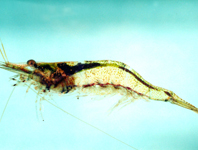Abstract
A new species of Reduviidae (Hemiptera: Heteroptera) from Caatinga ecosystem, Pyrrhosphodrus caatingensis Lapischies & Forero sp. nov., is described. The new species is distinguished from its congeners by its overall reddish coloration with black areas; by the black legs, with femora with a subapical yellowish broad ring, tibiae with apical and subapical yellowish annuli; and genital characters. Comments about the biology, feeding habits, habitus, genitalic images, and a distribution map of the new species are given. In addition, the following synonymy is proposed: Pyrrhosphodrus militaris Stål, 1866 = P. theresina (Berg, 1879), syn. nov. A key to separate the known species of Pyrrhosphodrus Stål, 1866 is provided.
References
Ang, Y., Wong, L.J. & Meier, R. (2013) Using seemingly unnecessary illustrations to improve the diagnostic usefulness of descriptions in taxonomy—a case study on Perochaeta orientalis (Diptera, Sepsidae). ZooKeys, 355, 9–27.
https://doi.org/10.3897/zookeys.355.6013
Berg, C. (1879) Hemiptera Argentina enumeravit speciesque novas. Pauli E. Coni ed., Buenos Aires, 316 pp.
https://doi.org/10.5962/bhl.title.36493
Bérenger, J.M. (2006) Un nouveau genre d’Apiomerini du Brésil (Heteroptera, Reduviidae, Harpactorinae). Nouvelle Revue d’Entomologie, 22, 369–375.
Cobben, R.H. & Wygodzinsky, P. (1975) The Heteroptera of the Netherlands Antilles—IX Reduviidae (Assassin bugs). Studies on the Fauna of Curaçao and other Caribbean Islands, 158, 1–62.
Davis, N.T. (1966) Contributions to the morphology and phylogeny of the Reduvioidea (Hemiptera: Heteroptera). Part III. The male and female genitalia. Annals of the Entomological Society of America, 59, 911–924.
https://doi.org/10.1093/aesa/59.5.911
Davis, N.T. (1969) Contribution to the morphology and phylogeny of the Reduvioidea. Part IV. The Harpactoroid complex. Annals of the Entomological Society of America, 62, 74–94.
https://doi.org/10.1093/aesa/62.1.74
Fallou, C.F. (1887) Diagnoses d’Hémiptères nouveaux de Minas Geraes. Le Naturaliste, 2, 68.
Forattini, O. & Serra, O. (1950) Contribuição ao conhecimento da morfologia e biologia de Pyrrhosphodrus militaris Stål, 1866 (Hemiptera, Harpactorinae). Dusenia, 1, 229–236.
Forero, D., Weirauch, C. & Baena, M. (2004) Synonymy of the reduviid (Hemiptera: Heteroptera) genus Torrealbaia (Triatominae) with Amphibolus (Harpactorinae), with notes on Amphibolus venator (Klug, 1830). Zootaxa, 670 (1), 1–12.
https://doi.org/10.11646/zootaxa.670.1.1
Forero, D. (2011) Classification of Harpactorinae assassin bugs (Hemiptera: Heteroptera: Reduviidae). Boletín del Museo Entomológico Francisco Luis Gallego, 3, 9–24. [ISSN 2027-4378]
Forero, D. & Weirauch, C. (2012) Comparative genitalic morphology in the New World resin bugs Apiomerini (Hemiptera, Heteroptera, Reduviidae, Harpactorinae). Deutsche Entomologische Zeitschrift, 59, 5–41.
https://doi.org/10.1002/mmnd.201200001
Gil-Santana, H., Salomão, A. & Oliveira, J. (2017) First description of the male and redescription of the female of Parahiranetis salgadoi Gil-Santana (Hemiptera, Reduviidae, Harpactorinae). ZooKeys, 671, 19–48.
https://doi.org/10.3897/zookeys.671.11985
IBGE (2016) Available from: ftp://geoftp.ibge.gov.br/ (accessed 20 October 2016)
Leal, I.R., Tabarelli, M. & Silva, J.M.C. (2003) Ecologia e Conservação da Caatinga. Editora Universitária UFPE, Recife, 822 pp.
Maldonado Capriles, J. (1990) Systematic catalogue of the Reduviidae of the World. Caribbean Journal of Science, University of Puerto Rico, Mayagüez, 355 pp.
https://doi.org/10.1093/aesa/85.4.532
Maldonado Capriles, J., Santiago-Blay, J.A. & Poinar, G.O. (1993) Apicrenus fossilis n. gen & n. sp. (Heteroptera: Reduviidae: Apiomerinae) from Dominican amber (lower Oligocene—upper Eocene). Entomologica Scandinavica, 24, 139–142.
https://doi.org/10.1163/187631293X00244
McPherson, J.E. & Ahmad, I. (2011) Parasinea, a new genus of assassin bug, with description of a new species from Colombia (Hemiptera: Heteroptera: Reduviidae). Annals of the Entomological Society of America, 104, 1285–1291.
https://doi.org/10.1603/AN11128
Putshkov, V.G. & Putshkov, P.V. (1985) A catalogue of assassin-bug genera of the World (Heteroptera, Reduviidae). Published by the authors, deposited in VINITI [All-Union Institute of Sci. & Techn. Information, No. 4738-B, 85 pp. [Russian preface, English main text], Kiev.
Putshkov, V.G. & Putshkov, P.V. (1988) A catalogue of assassin-bugs of the World (Heteroptera, Reduviidae). III. Harpactorinae. Published by the authors, deposited in VINITI (All-Union Institute of Sci. & Techn. Information, No. 286-В), Moskva, 88 pp. [Russian preface, English main text]
Silva, J.M.C., Leal, I.R. & Tabarelli, M. (2018) Caatinga—the largest tropical dry forest region in South America. Springer, Dordrecht, 482 pp.
https://doi.org/10.1007/978-3-319-68339-3
Stål, C. (1866) Bidrag till Reduviidernas kännedom. Öfversigt af Kongliga Vetenskaps—Akademiens Förhandlingar, 9, 235–302.
Vasconcellos, A., Andreazze, R., Almeida, A.M., Araujo, H.F.P., Oliveira, E.S. & Oliveira, U. (2010) Seasonality of insects in the semi-arid Caatinga of northeastern Brazil. Revista Brasileira de Entomologia, 54, 471–476.
https://doi.org/10.1590/S0085-56262010000300019
Weirauch, C., Berenger, J.M., Berniker, L., Forero, D., Forthman, M., Frankenberg, S., Freedman, A., Gordon, E., Hoey-Chamberlain, R., Hwang, W.S., Marshall, S.A., Michael, A., Paiero, S.M., Udah, O., Watson, C., Yeo, M., Zhang, G. & Zhang, J. (2014) An illustrated identification key to assassin bug subfamilies and tribes. Canadian Journal of Arthropod Identification, 26, 1–115.
https://doi.org/10.3752/cjai.2014.26
Wygodzinsky, P. (1947) Contribuição ao conhecimento do gênero Heniartes Spinola, 1837 (Apiomerinae, Reduviidae, Hemiptera). Arquivos do Museu Nacional, 41, 3–65.
Wygodzinsky, P. (1949) Elenco sistemático de los Reduviformes Americanos. Instituto de Medicina Regional, Tucumán, 102 pp.
Zhang, G. & Weirauch, C. (2013) Sticky predators: a comparative study of sticky glands in harpactorine assassin bugs (Insecta: Hemiptera: Reduviidae). Acta Zoologica, 94, 1–10.
https://doi.org/10.1111/j.1463-6395.2011.00522.x
Zhang, G. & Weirauch, C. (2014) Molecular phylogeny of Harpactorini (Insecta: Reduviidae): correlation of novel predation strategy with accelerated evolution of predatory leg morphology. Cladistics, 30, 339–351.
https://doi.org/10.1111/cla.12049
Zhang, J., Weirauch, C., Zhang, G. & Forero, D. (2016) Molecular phylogeny of Harpactorinae and Bactrodinae uncovers complex evolution of sticky trap predation in assassin bugs (Heteroptera: Reduviidae). Cladistics, 32, 538–554.
https://doi.org/10.1111/cla.12140

